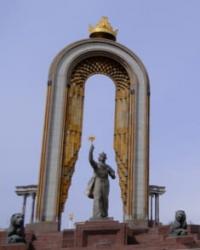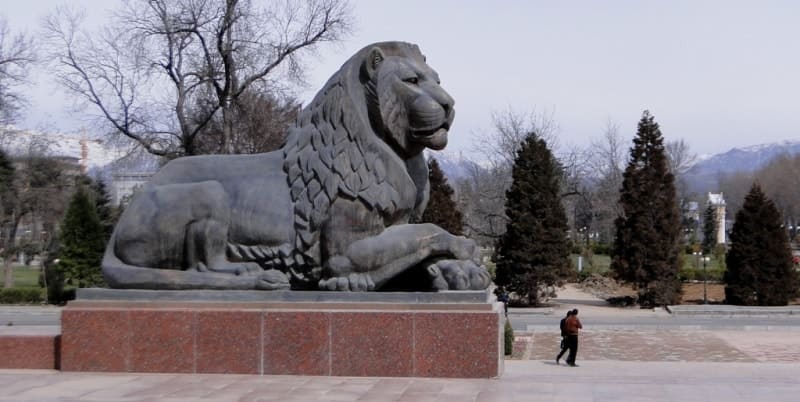You are here
Ismoili Somoni Monument in Dushanbe.

Monuments in Dushanbe.
“It’s better to be asked why they didn’t erect a monument to me, than vice versa”
Cato the Elder.
Tours across historical places in Dushanbe.
The memorial complex of national unity of Tajikistan is installed on the central Friendship Square (Dusti, the former Lenin, Freedom, Ozodi Square) in the city of Dushanbe, which since the late 1990s also bore the name of Ismail Samani in the form of a monument to Ismail Samani, emir from the Samanid dynasty, the founder of the first states of the Tajiks.
Officially, the monument, together with a museum dedicated to the Samanids and their state, was opened in a solemn atmosphere in 1999 in honor of the 1100th anniversary of the Samanids states. Since then, according to the protocol, a visit to the monument has been mandatory for high-level international delegations.
The monument to Ismail Somoni is the main attraction on Dusti Square and the main symbol of the city. The monument was erected in 1997 and is 13 meters high. The monument and the arch, as elements of the memorial complex, were made in Russia.
A beautiful arch rises directly above it, the total height of which exceeds 43 meters. This monument depicts the main symbols of Tajik statehood: a crown and a scepter, decorated with seven stars. One of the authors of the 13-meter sculpture is the Russian sculptor Lev Kerbel.
Somoni holds in his hand a golden scepter with the image of a solar disk as a symbol of the unity of the nation and the state. The monument is installed in an arch, 40 meters high, at the top there is a crown covered with gold leaf.
All parts of this yellow monument are cast in solid gold, so it is under constant surveillance by Tajik law enforcement agencies. The Samanid ruler proudly looks ahead, holding a golden scepter in his right hand. The scepter is made in the form of a solar disk, from which rays of goodness, peace and vitality depart.
A huge arch, symbolizing the vault of heaven, crowned with a golden toj crown. The lions at Ismail's feet represent fire, and the fountains represent the element of water. A model of the Samanid mausoleum in Bukhara was built under the monument.
Bronze lions lay down on both sides of the monument. The shape of the arch was borrowed by Zukhuruddinov from the ornamentation of ancient Russian icons. So this monument erected on the square with the symbolic name "Dusti-Druzhba" is a product of Russian-Tajik cooperation." All festive events are held on this square.
Abu Ibrahim Ismail Ibn Ahmad Samani (Pers. ابو ابراهیم اسماییل بن احمد امانی), also known as Ismail Samani (Pers. اسماییل سامانی) - Emir from the Samanid dynasty, the founder of the state in Central Asia. There are several assumptions about the birthplace of Ismail.
Researchers note Fergana and Balkh. Ismail was born into the family of a local aristocrat, Ahmad, the son of Asad, the grandson of Saman-Khudat. Ismail was the governor of his brother Nasr in Bukhara (874 - 892).
In 888, he defeated his brother, but retained his power. Only after the death of his brother did he become the emir of Maverannahr and in 892 he was approved as caliph in this country. After the elimination of civil strife and rebellions and the establishment of his autocracy, he had to deal with ensuring the security of the state from the raids of the Turkic nomads.
In 893, he undertook a campaign to Taraz, conquered the city and the Talas valley, in which rich silver mines were located. The growing role of the Samanids in Transoxiana and the Saffarids in Khorasan greatly worried the caliphs of Baghdad.
In 898, the caliph issued a rescript on the deposition of Ismail and the appointment of Saffarid Amr ibn Leys as the governor of Maverannahr. Despite this, after Ismail Samani (900) won the battle of Balkh, the caliph expressed his satisfaction to the winner.
The legacy of the Saffarids in Khorasan was disputed with the Samanids by Muhammad ibn Zeid, the ruler of Tabaristan. The commander of Ismail Mohammed ibn Harun managed not only to expel the enemies from Khorasan, but even to conquer Tabaristan.
However, after that, he rebelled against his sovereign, adopted the white color - the color of those who rebelled against the legitimate government - and captured Rey. Ismail himself had to oppose the rebellious commander.
After the victory over him, Rey and Qazvin were annexed to the Samanid state and, thus, the borders of the latter in the west were established (902). In 904, in the east, with the help of volunteers from other Muslim countries, the invasion of a numerous Turkic people was repelled.
In the city of Bukhara in Uzbekistan, the tomb of the Samanid dynasty, an outstanding architectural monument, has been preserved. Bukhara under Ismail Samani was the capital of the Samanid state. It is interesting that in “Tavarikh-i guzida-yi nusrat-name” it is noted that the wife of the ancestor of the ruler of the second half of the XVth - early XVIth century Muhammad Sheibani-khan - Ming-Timur was the daughter of Jandi-bek, who was a descendant of Ismail Samani.
The name of Ismail Samani since 1998 has been the highest peak of the former USSR (formerly Communism Peak), as well as an urban-type settlement and one of the four districts of Dushanbe. In 1999, the celebration of the 1100th anniversary of the Samanid state took place in Tajikistan, in Dushanbe, on Dusti Square, an architectural ensemble of Ismailu Samani 13 meters high was erected.
Several monuments to Ismail Samani adorned the cities of Tajikistan - Dushanbe, Penjikent, Khujand, Gafurov, Kurgan-Tube, Khorog.
In Tajikistan, in memory of the founder of the state, the Order of Ismoili Somoni was established, a banknote with the image of the ruler was put into circulation, administrative districts, urban settlements, squares, squares and streets of cities and towns were named after him.
Geographical coordinates of Somoni monument in Dushanbe: N38°34'26 E68°47'07




Authorship:
Javad Abed Khorasani. http://www.asraresokhan.com
Photos by
Alexander Petrov.







